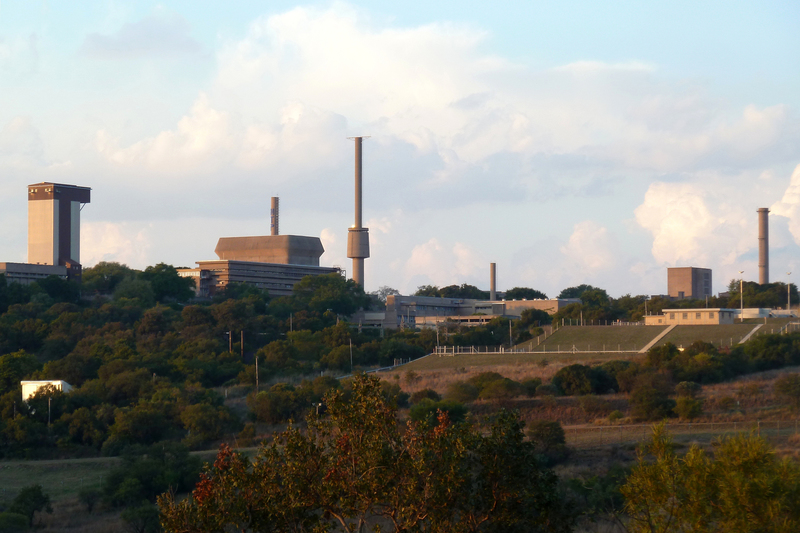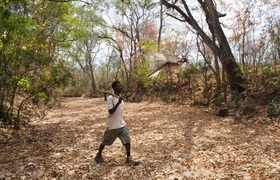Shutting down SA’s nuclear future
16 July 2019 | Story David Fig. Photo JMK, Wikipedia. Read time 6 min.
Located 33 km west of South Africa’s capital city Pretoria, the Pelindaba precinct has been home to South Africa’s official nuclear research corporation since the 1960s. The Nuclear Energy Corporation of South Africa (NECSA) hosts the country’s earliest nuclear reactor, originally designed to take weapons-grade uranium. It was also the original site for the development of nuclear weapons under the apartheid government between 1978 and 1990.
Over the years the corporation has experimented with reactor development, uranium enrichment, fuel fabrication, and the production of isotopes used in nuclear medicine.
In the years to 1994, it was given relatively free range with budgets and personnel to conduct these experiments. The whims of nuclear scientists were indulged as they were seen to be essential to apartheid’s semi-clandestine weapons, energy and sanctions-busting plans. However, many of these projects – except for the isotopes, which remain lucrative – have been abandoned.
In recent years, governance has become dysfunctional. The corporation no longer sustains itself financially, there have been tensions between ministers and the board and the production of medial isotopes ceased for over a year.
Long-standing problems
Problems in the running of the corporation have been evident for some time.
Earlier this year the former energy minister Jeff Radebe dealt with the growing internal problems by suspending and later firing the CEO, Phumzile Tshelane. He also took steps to fire the organisation’s entire board.
Radebe acted because he claimed the board had failed in its fiduciary duties. This included oversight of the shut down of the production of isotopes for over a year, rendering NECSA in grave debt. Another reason was the signing of a deal with Russia’s Rosatom to build two “solution reactors” in South Africa. Radebe regarded the co-operation agreement irregular.
In December 2018, Radebe appointed former NECSA CEO Rob Adam as the new non-executive chair of the board. In July this year Adam confirmed he had resigned. In seven months the task of restoring NECSA to functionality had become too onerous and time-consuming.
Adam’s resignation signals grave difficulties faced by NECSA in its attempts to restructure and improve its balance sheet. Most worrying is that NECSA has spun off its former waste management responsibilities to a recent formation, the National Radioactive Waste Disposal Institute, which has also experienced severe governance problems.
The future
NECSA was the heir of an earlier Atomic Energy Board, which entered its life at the outset of the apartheid regime on 1 January 1949. At the time there was much debate about where to locate atomic research. Some sections of the scientific establishment argued that it should become part of the government-sponsored Council for Scientific and Industrial Research (CSIR). However, security and military issues prevailed and atomic research was hived off into its own enterprise.
South Africa, in deciding on NECSA’s future, should consider that for the present the country has decided to give up its nuclear ambitions, specifically in the area of energy generation. In 2010 the government wound up South Africa’s attempts at designing a high-temperature small-scale reactor, the Pebble Bed Modular reactor.
The project failed to attract foreign investors and customers, and Eskom was reluctant to become a guinea pig. Cost and time overruns became too burdensome. Expensive enrichment technologies had also failed to become cost effective, and when unhooked from bomb production, were terminated.
Isotope production is still viable. But the question is whether it requires an entire Pelindaba-sized research establishment to proceed. The reactor is now too elderly to have a bright future, and there’s no money to replace it.
South Africa’s plans to build a series of nuclear power stations, championed by former president Jacob Zuma, were halted in 2017. This followed litigation by two environmental NGOs – Earthlife Africa and the Southern African Faith Communities’ Environmental Institute. This decision, as well as the draft contents of the Integrated Resource Plan 2018 underscore that, for the time being, extra nuclear capacity is unviable.
What to do with the facility
Now that South Africa no longer ascribes to a nuclear energy future, it is legitimate to consider what to do with the Pelindaba facility. The suitably pared-down nuclear research establishment needs to be reconceptualised and relocated.
NECSA should be dismantled and its legacy projects, where viable, should be housed inside institutions like the CSIR and the universities. Nuclear scientists could be retired or retrained, while the rest of the workforce could be subjected to a “just transition” along the lines proposed in the carbon-intensive industries.
Pelindaba as a precinct could be repurposed. First the nuclear waste from previous activities which is housed in numerous buildings and trenches at Pelindaba would need to be decontaminated and removed, so that future users can avoid any exposure to radioactivity.
The site could become a new campus dedicated to innovation in the field of sustainable energy and related sciences. Subsidies once dedicated to nuclear research could be redirected to repositioning South Africa as a leading energy innovator in the global South. The new Pelindaba could also be dedicated to finding Africa-wide solutions to the climate crisis.
Part of the site could also be dedicated to promoting nuclear disarmament. After all, the Treaty of Pelindaba declared the African continent a nuclear weapons-free zone. South Africa, the first country to give up its nuclear weapons, has a duty to the rest of the continent to champion nuclear disarmament.
Repurposing of Pelindaba would be a just, cost-effective and practical solution to the problem of taxpayers continuing to support an increasingly dysfunctional NECSA, especially since nuclear energy is no longer seen as a viable way forward.![]()
David Fig, Honorary Research Associate, University of Cape Town.










